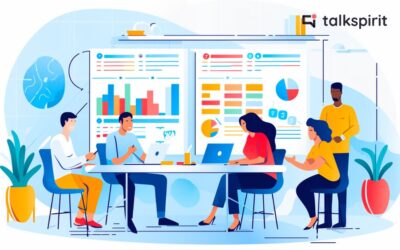Establishing correlations or isolating respective consequences isn’t easy, but, two phenomena have caused unprecedented upheaval over the last 20 years in how companies operate: on one hand, the new capabilities offered by the Internet, and on the other, the evolution of employees’ mentalities. In less than a generation, the boundaries of time and the traditional workspace have disappeared, ways of interacting and collaborating have been transformed, and links between individuals and their organizations have been profoundly redefined.
It’s important to go back over these upheavals to see how to better guide them.
[This article is extracted from the White Paper “Digitization: French SMEs at a crossroads” >>> access the full White Paper for free]
The disappearance of time and (work) space
As early as 1990, with the arrival of the personal computer, employees in the tertiary sector (traditional white-collar workers) began to go back to work—at home—after dinner. But it was with the widespread use of laptops first, then smartphones, that the boundaries of time and workspace were definitively blurred. With their laptops still in front of them, employees began to handle emails/messages/business calls on public transportation, in the street, at the hairdresser’s, at the supermarket checkout, in the park, and even from their vacation spot. Work has invaded personal space to be sure, but it also offers us new flexibility to reconcile personal and professional constraints on a daily basis.
Davricourt takes care of the personal life of its consultants
A Great Place to Work 2018 winner, the Davricourt consulting firm (with more than 350 employees in France) uses its internal social network to promote well-being among employees. A Davri-list group has been created to facilitate the sharing of classified ads and the exchange of services between colleagues. The result for employees: saving time and money, and above all, the feeling that their employer makes their life easier. This also allows for a better work-life balance, something that is often criticized in the consulting sector due to the pace of life imposed on employees.
Also read: “Communicating better with employees around the world” by DAVRICOURT
Unsurprisingly, the porosity of the boundary between professional and personal life appears to the same extent in the workplace. Indeed, it’s not uncommon for employees to use their professional digital tools (telephone and laptop and software installed on them) for their own use. Some employers even present this as an in-kind benefit.
In any case, the company of 2020 has everything to gain from facilitating work “anytime, anywhere.” However, it must also respect and facilitate the right to disconnect—a fragile balance that can be difficult to achieve.
The information exchange boom
The arrival of devices full of capture instruments (cameras, microphones, touch screens) and processing software (document management, photo retouching, video editing, etc.) has transformed every Internet user into a data producer. At any given moment, each Internet user is in turn a consumer and contributor of content to his or her environment (friends, family). Obviously, the same goes on within companies.
Within a decade, production of digital data has literally exploded, so that the volume of new data produced is now measured in zettabytes (1 ZB = 1 billion TB). The German institute Statista estimates data production at +45 ZB over the period 2010-2020, and already predicts that more than 565 ZB of data will be produced over the next decade. That’s quite simply staggering (see below).
Of course, your company is no exception. In order to function, it consumes and produces thousands of pieces of information every day (CRM data, statistics, technical specifications, notes, procedures, connection logs, project progress reports, numerical analysis reports, emails, to-do lists, action plans, dashboards, etc.).
Among these key data, those related to knowledge and training are central. Indeed, we are seeing new dynamics of expertise sharing that respond to a need to share and disseminate knowledge, to ensure transmission on one hand and the increase in team skills on the other. Webinars, virtual classes, online courses, coaching by videoconference: all these formats facilitate knowledge sharing between your employees. In the same way, collaborative intelligence, sharing of best practices, daily mutual aid via collaborative platforms (such as Talkspirit, Teams, Jamespot, for example) and document co-editing (via Google Docs, Office Online or OnlyOffice, for example) are the expression of this knowledge sharing.
The challenge of capitalizing on knowledge is the reason why most companies provide their employees with a shared document base—either via on-premise servers secured by the company itself or in one of the private or shared cloud solutions (such as OVHcloud, Google Drive, OneDrive). Thus managed, all your documentation is always organized (tree structure, naming and versioning), updated (the cloud servers are permanently synchronized), accessible (anytime, anywhere and from any device) and protected (the administrator can easily set up which folders everyone has access to). A control appreciated by IT teams.
The rise of conversations
Driven by digital technologies both inside and outside the company, conversations have become ubiquitous. Whether they take place via SMS, telephone, instant messaging (Talkspirit, Teams, Slack, or even Whatsapp), videoconferencing software (Zoom, Skype, Whereby), an enterprise social network or a digital work environment, conversations are now at the heart of all our professional interactions.
Also read: 8 advantages of using an enterprise social network
The big loser in this phase of escalating conversations: email. Its massive use since the 1990s has made its shortcomings all too visible: an enormous flow to be sorted out every day, interminable exchanges, the impossibility of making a decision emerge from a conversation, the problem of Cc/Cci copying, data dispersion, or the impossibility for a newcomer to access past exchanges. In addition, we also realized the dangers of email for the company itself (loss and leakage of information or rapid obsolescence of sent documents, for example).
That’s why since 2010, enterprise social networks and other collaborative platforms have been gaining ground: they are better than email both in terms of productivity and user-friendliness. Thanks to these innovative tools, the company is doing double duty by offering its employees a pleasant and modern interface, in turn making them all the more efficient.
Bergamote Reduces Internal Emails by 95%
In just a few months, the Bergamote Agency (an editorial communication agency based in Paris) has overcome internal email bloating and streamlined all exchanges of information and documents among its employees—but also with customers. Its secret: a platform to collaborate and communicate to gain efficiency and agility on customer projects, where all stakeholders (internal and external) are invited. Find out more here: access case study.
Also read: 7 Unstoppable Arguments to Convince Your General Management to Deploy an Enterprise Social Network
Promoting real-time conversations in all forms (text, sound, video, image, emojis, animated GIFs), collaboration platforms have injected more interactivity into exchanges, relying for example on survey, task distribution and project management modules. But what these platforms bring to the table is the fact that each communication has become a conversation:
- Any internal communication message can be commented and discussed.
- Each collaborator has the opportunity to make his or her voice and opinion heard and to initiate a conversation, a survey, or to share a reflection or initiative.
- There’s no longer a single transmitter and a multitude of receivers. Everyone participates in exchanges.
In the end, with the expansion of the right to speak, digital has made the organization more flexible, making it both more responsive and more in tune with its environment.
The resurgence of individual commitment
The latest Gallup Institute studies show that in all developed countries, employee commitment is slipping. By mid-2019, just 15% of employees worldwide were truly committed to their work. In France, the situation is slightly better, with Gallup estimating that at the end of 2018 only 74% of French employees were not committed (although 20% said they were completely uncommitted). The cost of this lack of commitment represents a deep chasm. The IBET 2019 survey estimated €14,500 in lost revenue per employee per year in France. This lack of commitment indeed has concrete consequences: lower productivity, loss of initiative, sick leave, and resignations that require recruitment for a position that may continue to lose commitment.
Where does this disengagement come from? While the causes are numerous, experts show that employee fatigue is due to a combination of factors such as a loss of meaning, lack of career prospects, poor access to training, lack of recognition, insufficient leadership from managers, and often, an excessive workload.
Where is digital transformation in all this? Great news: it’s actually part of the solution!
Indeed, it requires managers to redefine the company’s raison d’être and to ask themselves the question of the meaning of this transformation (why and for what purpose?). The result is an opportunity to transform the employee experience:
- By connecting employees to each other (via a directory, a profile search engine and instant messaging, for example)
- By highlighting their initiatives and valuing their successes (personal and collective) in internal communication
- By asking for the teams’ opinion via video exchanges, surveys or calls for proposals
- By digitizing certain processes or procedures that still weigh on employees’ daily lives (leave requests, submission of expense reports, for example)
- By strengthening internal links—particularly through the creation of groups or communities on the internal social network (by project, by business, by location, by interest)
- By launching inter-team challenges to generate emulation, the desire to surpass oneself and mutual inspiration
- Encouraging and making use of training more flexible—particularly through e-learning
Reinvesting in your employees is one of the key opportunities that digital offers you. This results in a greater sense of belonging and more mutual consideration and recognition; in short, stronger individual commitment over the long haul.
This in turn will result in better productivity and performance.
Collaborating differently
Given the speed of the upheavals it’s brought upon us, digital technology has made work environments even more unpredictable than before (often referred to as VUCA for volatility, uncertainty, complexity and ambiguity). For an SME, VUCA is as much a source of anxiety as it is a chance for opportunities.
In a turbulent environment, companies and employees alike simply have to learn to work differently:
- At a distance or on the move to remain flexible in the face of external events (in the recent past: the Covid-19 crisis, for example)
- With new modes of interaction (videoconferencing, chat, webinar, livestream)
- With new tools (team messaging, task/project management, co-editable documents, files hosted in the cloud)
- In a logic that integrates the main business tools and the associated flows of information
All this to reproduce a work environment offering a quality of interaction and efficiency close to that which exists in real life. To succeed in this shift, the company and its leaders must devote resources to supporting teams.
Buffer, a company without offices
An American company created in 2013 by Joël Gascoigne and which today has 90 employees, Buffer has the particularity of having chosen a “deskless” model. That’s right: zero offices. Employees meet every quarter, but collaborate 100% remotely on a daily basis (from 15 different countries)! To learn more about this company, read the article on Alan’s blog.
So, working differently is also innovating differently—specifically, by relying on the four values of agility (from the Agile Manifesto) which leads to prioritize the following:
- Individuals and their interactions, rather than processes and tools
- Functional software rather than exhaustive documentation
- Collaborating with clients rather than negotiating contracts
- Adapting to change rather than executing a plan
Created for the software publishing sector but applicable to many other sectors, these four values lead us to change our vision in order to put the action at the service of the customer, as well as the quality of the product and experience it offers the customer. This implies more transparency on the progress of projects, more listening and interaction with the customer, and more frequent adjustments to existing plans, ultimately reducing the risk of spending time on unnecessary tasks.
To promote agility, the constitution of tribes (project groups/communities, business groups/communities)—composed of both internal and external stakeholders—is crucial. On a collaborative platform, these tribes offer the opportunity to share information, best practices, feedback, and the possibility to distribute tasks to the team, to follow a project or to measure the results. All in complete transparency and in real time.
Also read: Jonathan Chan: “Agility is Tomorrow’s Talent”
The CPAM of Bas-Rhin, at the forefront of digital transformation
Since 2016, the 1,200 employees of the Caisse primaire d’Assurance Maladie (French national health insurance fund) in Bas-Rhin have been working daily, both face-to-face and teleworking, via a collaborative platform developed entirely in France that brings employees closer together, multiplies exchanges, improves cross-functionality and tools agility (via teleworking)
→ See the testimony of Sylvie Mansion, General Manager of the CPAM du Bas-Rhin
The future of work is already here
Having overcome the shock of the arrival of digital tools in French SMEs and middle-market companies, they’re now facing a twofold challenge involving experience.
- Customer Experience: the company must provide the customer with a memorable experience at every touch point to maximize conversion rates and retention.
- The employee experience, on the other hand: the company must simplify the employee’s life (at least when they are at work) to reduce the risks of departure, increase employee satisfaction and individual commitment.
This focus on experience and the development of new cooperation dynamics has led to a broadening of the (virtual) boundaries of the company, from an exclusive notion (the company versus outsiders) to an inclusive notion (the company along with its external stakeholders). Thus, it’s no longer rare to see competing firms joining forces in cooperative efforts, i.e. in the form of collaboration or cooperation of circumstance or opportunity (joining forces with a supplier, for example).
Here’s what you can expect from this digital transformation of your work methods.
For each of your employees:
- Less time spent searching for information
- Less time spent dealing with the flow of emails
- Less time spent in meetings
- Easier to manage and share information and documents
- A richer collaborative work experience
- More proximity between peers
On the company level (SME / SMI):
- Greater transparency that provides a better understanding of what is going on inside and outside the organization
- Return to a culture of surpassing oneself
- A stronger sense of belonging
- More information sharing and self-help behaviors
- A better proximity with your customers
Ready for the challenge?
*
* *
Want to learn more about the challenges of the future of work? Read our white paper: “Future of Work: Make Way for Hybrid Work.”
Access White Paper
In our white paper “The Future of Work: Make Way for Hybrid Work!” you’ll discover the eight main challenges of hybrid work; best practices managers, HR, internal communication, IT and employees all can adopt; and the tools for facilitating hybrid work.
—
Author: Benoît Renoul



